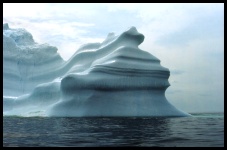
 Sea Sculpts Bergs Icebergs are very unstable. The highly random shape and non-uniform melting can lead to frequent shifts. Tabular bergs are generally the most stable, but domed and wedge shaped ones may roll over completely in just seconds - and without any warning! Sometimes icebergs become "grounded" near shore. When the tide rises and falls the sea ice rises and falls with it - but the iceberg doesn't. This creates all kinds of scraping, creaking and groaning noises as pack ice rubs up and down the uneven sides of the berg. Icebergs often make other creaks, groans, growls and bangs as the sun heats up the surface. If the ice breaks and a big piece falls off, it may make the berg unstable, causing it to tip or roll into another position. Huge breaks, tips or rolls can cause waves and ripples that break up the surface of the surrounding sea ice. If you're using the pack ice as a platform to view unstable bergs, you may find yourself floating in the water as well!
Click pictures for more information and credits. Library: Arctic, Icebergs, Glaciers, Ice Links: Arctic, Icebergs Maps: Iceberg Source Arctic Maps & Weather Reports |

|
DICTIONARY: Just "double-click" any unlinked word on this page for the definition from Merriam-Webster's Student Electronic Dictionary at Word Central. |

|
ARCTIC LIBRARY & GLOSSARY: Check this section for an index of the rest of the things you really need to know about the Arctic. |

|
ARCTIC MAPS & WEATHER REPORTS: Maps of the Northwest Passage, explorers' routes, iceberg sources, Nunavut, the Arctic by treeline, temperature... |

|
ARCTIC LINKS: Even more information! Links to sites related to the Arctic and "Iceberg: the Story of the Throps and the Squallhoots". |

|
GUIDE TO ARCTIC SUNRISE & SUNSET: How much sunlight or darkness is there in the Arctic on each day of the year? |
to is the property of their respective owners, and Athropolis is not responsible for their content.